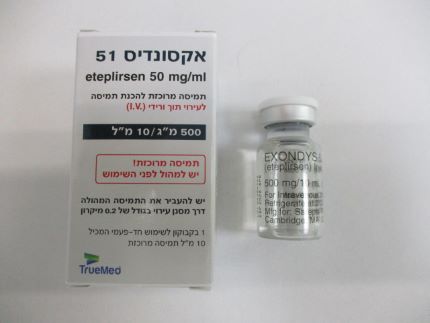Quest for the right Drug

אקסונדיס 51 EXONDYS 51 (ETEPLIRSEN)
תרופה במרשם
תרופה בסל
נרקוטיקה
ציטוטוקסיקה
צורת מתן:
תוך-ורידי : I.V
צורת מינון:
תרכיז להכנת תמיסה לאינפוזיה : CONCENTRATE FOR SOLUTION FOR INFUSION
עלון לרופא
מינוניםPosology התוויות
Indications תופעות לוואי
Adverse reactions התוויות נגד
Contraindications אינטראקציות
Interactions מינון יתר
Overdose הריון/הנקה
Pregnancy & Lactation אוכלוסיות מיוחדות
Special populations תכונות פרמקולוגיות
Pharmacological properties מידע רוקחי
Pharmaceutical particulars אזהרת שימוש
Special Warning עלון לרופא
Physicians Leaflet
Pharmacological properties : תכונות פרמקולוגיות
Pharmacodynamic Properties
12.2 Pharmacodynamics All EXONDYS 51-treated patients evaluated (n=36) were found to produce messenger ribonucleic acid (mRNA) for a truncated dystrophin protein by reverse transcription polymerase chain reaction. In Study 2, the average dystrophin protein level in muscle tissue after 180 weeks of treatment with EXONDYS 51 was 0.93% of normal (i.e., 0.93% of the dystrophin level in healthy subjects). Because of insufficient information on dystrophin protein levels before treatment with EXONDYS 51 in Study 1, it is not possible to estimate dystrophin production in response to EXONDYS 51 in Study 1. In Study 3, the average dystrophin protein level was 0.16% of normal before treatment, and 0.44% of normal after 48 weeks of treatment with EXONDYS 51 [see Clinical Studies (14)]. The median increase in truncated dystrophin in Study 3 was 0.1% [see Clinical Studies (14)]. Dystrophin levels assessed by western blot can be meaningfully influenced by differences in sample processing, analytical technique, reference materials, and quantitation methodologies. Therefore, comparing dystrophin results from different assay protocols will require a standardized reference material and additional bridging studies.
Pharmacokinetic Properties
12.3 Pharmacokinetics Following single or multiple intravenous infusions of EXONDYS 51 in male pediatric DMD patients, plasma concentration-time profiles of eteplirsen were generally similar and showed multi-phasic decline. The majority of drug elimination occurred within 24 hours. Approximate dose-proportionality and linearity in PK properties were observed following multiple-dose studies (0.5 mg/kg/week [0.017 times the recommended dosage] to 50 mg/kg/week [1.7 times the recommended dosage]). There was no significant drug accumulation following weekly dosing across this dose range. The inter-subject variability for eteplirsen Cmax and AUC range from 20 to 55%. Following single or multiple intravenous infusions of EXONDYS 51, the peak plasma concentrations (Cmax) of eteplirsen occurred near the end of infusion (i.e., 1.1 to 1.2 hours across a dose range of 0.5 mg/kg/week to 50 mg/kg/week). Distribution In vitro investigation suggested that plasma protein binding of eteplirsen in human ranges between 6 to 17%. The mean apparent volume of distribution (Vss) of eteplirsen was 600 mL/kg following weekly intravenous infusion of EXONDYS 51 at 30 mg/kg. Twenty-four hours after the end of the infusion, mean concentrations of eteplirsen were 0.07% of Cmax. Accumulation of eteplirsen during once weekly dosing has not been observed. Elimination The total clearance of eteplirsen was 339 mL/hr/kg following 12 weeks of therapy with 30 mg/kg/week. Metabolism Eteplirsen did not appear to be metabolized by hepatic microsomes of any species tested, including humans. Excretion Renal clearance of eteplirsen accounts for approximately two-thirds of the administered dose within 24 hours of intravenous administration. Elimination half-life (t1/2) of eteplirsen was 3 to 4 hours. Specific Populations Age: The pharmacokinetics of eteplirsen have been evaluated in male pediatric DMD patients. There is no experience with the use of EXONDYS 51 in patients 65 years of age or older. Sex: Sex effects have not been evaluated; EXONDYS 51 has not been studied in female patients. Race: Potential impact of race is not known because 89% of the patients in studies were Caucasians. Patients with Renal Impairment: The effect of renal impairment on the pharmacokinetics of eteplirsen was evaluated in non-DMD subjects aged 51 to 75 years with mild (n=8, creatinine clearance ≥60 mL/min and <90 mL/min) or moderate (n=8, creatinine clearance ≥30 mL/min and <60 mL/min) renal impairment and matched healthy subjects (n=9, creatinine clearance >90 mL/min). Subjects received a single 30 mg/kg intravenous dose of eteplirsen. Subjects with mild and moderate renal impairment showed higher eteplirsen exposure compared to subjects with normal renal function. In subjects with mild and moderate renal impairment, exposure (AUC) increased approximately 1.4-fold and 2.4-fold, respectively. The effect of severe renal impairment or end-stage renal disease on eteplirsen pharmacokinetics and safety has not been studied. Estimated creatinine clearance values derived from the Cockcroft-Gault equation and the threshold definitions for mild, moderate, and severe renal impairment in otherwise healthy adults would not be generalizable to patients with DMD. Therefore, no specific dosage adjustment can be recommended for patients with renal impairment. Patients with Hepatic Impairment: EXONDYS 51 has not been studied in patients with hepatic impairment. Drug Interaction Studies In vitro data showed that eteplirsen did not significantly inhibit CYP1A2, CYP2B6, CYP2C8, CYP2C9, CYP2C19, CYP2D6, or CYP3A4/5. Eteplirsen did not induce CYP2B6 or CYP3A4, and induction of CYP1A2 was substantially less than the prototypical inducer, omeprazole. Eteplirsen was not a substrate nor did it have any major inhibitory potential for any of the key human transporters tested (OAT1, OAT3, OCT1, OCT2, OATP1B1, OATP1B3, P-gp, BCRP, MRP2 and BSEP). Based on in vitro data on plasma protein binding, CYP or drug transporter interactions, and microsomal metabolism, eteplirsen is expected to have a low potential for drug-drug interactions in humans.

שימוש לפי פנקס קופ''ח כללית 1994
לא צוין
תאריך הכללה מקורי בסל
לא צוין
הגבלות
לא צוין
מידע נוסף
עלון מידע לרופא
07.03.22 - עלון לרופאעלון מידע לצרכן
07.03.22 - החמרה לעלוןלתרופה במאגר משרד הבריאות
אקסונדיס 51